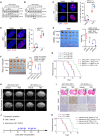Acquired temozolomide resistance in MGMT-deficient glioblastoma cells is associated with regulation of DNA repair by DHC2
- PMID: 31347685
- PMCID: PMC6658867
- DOI: 10.1093/brain/awz202
Acquired temozolomide resistance in MGMT-deficient glioblastoma cells is associated with regulation of DNA repair by DHC2
Abstract
The acquisition of temozolomide resistance is a major clinical challenge for glioblastoma treatment. Chemoresistance in glioblastoma is largely attributed to repair of temozolomide-induced DNA lesions by O6-methylguanine-DNA methyltransferase (MGMT). However, some MGMT-deficient glioblastomas are still resistant to temozolomide, and the underlying molecular mechanisms remain unclear. We found that DYNC2H1 (DHC2) was expressed more in MGMT-deficient recurrent glioblastoma specimens and its expression strongly correlated to poor progression-free survival in MGMT promotor methylated glioblastoma patients. Furthermore, silencing DHC2, both in vitro and in vivo, enhanced temozolomide-induced DNA damage and significantly improved the efficiency of temozolomide treatment in MGMT-deficient glioblastoma. Using a combination of subcellular proteomics and in vitro analyses, we showed that DHC2 was involved in nuclear localization of the DNA repair proteins, namely XPC and CBX5, and knockdown of either XPC or CBX5 resulted in increased temozolomide-induced DNA damage. In summary, we identified the nuclear transportation of DNA repair proteins by DHC2 as a critical regulator of acquired temozolomide resistance in MGMT-deficient glioblastoma. Our study offers novel insights for improving therapeutic management of MGMT-deficient glioblastoma.
Keywords: CBX5; DHC2; XPC; acquired TMZ resistance; glioblastoma.
© The Author(s) (2019). Published by Oxford University Press on behalf of the Guarantors of Brain.
Figures






Similar articles
-
USP7 promotes temozolomide resistance by stabilizing MGMT in glioblastoma.Cell Death Dis. 2025 Aug 20;16(1):631. doi: 10.1038/s41419-025-07969-3. Cell Death Dis. 2025. PMID: 40835840 Free PMC article.
-
A co-formulation of interferons type I and II enhances temozolomide response in glioblastoma with unmethylated MGMT promoter status.Mol Biol Rep. 2020 Jul;47(7):5263-5271. doi: 10.1007/s11033-020-05604-2. Epub 2020 Jun 30. Mol Biol Rep. 2020. PMID: 32607953
-
Recycling of SLC38A1 to the plasma membrane by DSCR3 promotes acquired temozolomide resistance in glioblastoma.J Neurooncol. 2022 Mar;157(1):15-26. doi: 10.1007/s11060-022-03964-2. Epub 2022 Feb 21. J Neurooncol. 2022. PMID: 35187626
-
Treatment considerations for MGMT-unmethylated glioblastoma.Curr Neurol Neurosci Rep. 2015 Jan;15(1):507. doi: 10.1007/s11910-014-0507-z. Curr Neurol Neurosci Rep. 2015. PMID: 25394859 Review.
-
MGMT Expression Contributes to Temozolomide Resistance in H3K27M-Mutant Diffuse Midline Gliomas and MGMT Silencing to Temozolomide Sensitivity in IDH-Mutant Gliomas.Neurol Med Chir (Tokyo). 2018 Jul 15;58(7):290-295. doi: 10.2176/nmc.ra.2018-0044. Epub 2018 May 31. Neurol Med Chir (Tokyo). 2018. PMID: 29848907 Free PMC article. Review.
Cited by
-
TMEFF2 promoter hypermethylation is an unfavorable prognostic marker in gliomas.Cancer Cell Int. 2021 Mar 4;21(1):148. doi: 10.1186/s12935-021-01818-x. Cancer Cell Int. 2021. PMID: 33663520 Free PMC article.
-
Enhanced Anti-Tumor Activity in Mice with Temozolomide-Resistant Human Glioblastoma Cell Line-Derived Xenograft Using SN-38-Incorporated Polymeric Microparticle.Int J Mol Sci. 2021 May 24;22(11):5557. doi: 10.3390/ijms22115557. Int J Mol Sci. 2021. PMID: 34074038 Free PMC article.
-
Cyanidin-3-O-glucoside inhibits the β-catenin/MGMT pathway by upregulating miR-214-5p to reverse chemotherapy resistance in glioma cells.Sci Rep. 2022 May 11;12(1):7773. doi: 10.1038/s41598-022-11757-w. Sci Rep. 2022. PMID: 35545654 Free PMC article.
-
A tale of two multi-focal therapies for glioblastoma: An antibody targeting ELTD1 and nitrone-based OKN-007.J Cell Mol Med. 2022 Jan;26(2):570-582. doi: 10.1111/jcmm.17133. Epub 2021 Dec 14. J Cell Mol Med. 2022. PMID: 34910361 Free PMC article.
-
High expression of PYCARD is an independent predictor of unfavorable prognosis and chemotherapy resistance in glioma.Ann Transl Med. 2021 Jun;9(12):986. doi: 10.21037/atm-21-2346. Ann Transl Med. 2021. PMID: 34277786 Free PMC article.
References
-
- Batista LF, Roos WP, Christmann M, Menck CF, Kaina B. Differential sensitivity of malignant glioma cells to methylating and chloroethylating anticancer drugs: p53 determines the switch by regulating xpc, ddb2, and DNA double-strand breaks. Cancer Res 2007; 67: 11886–95. - PubMed
-
- Batty D, Rapic’-Otrin V, Levine AS, Wood RD. Stable binding of human XPC complex to irradiated DNA confers strong discrimination for damaged sites. J Mol Biol 2000; 300: 275–90. - PubMed
Publication types
MeSH terms
Substances
LinkOut - more resources
Full Text Sources
Other Literature Sources
Medical
Research Materials

